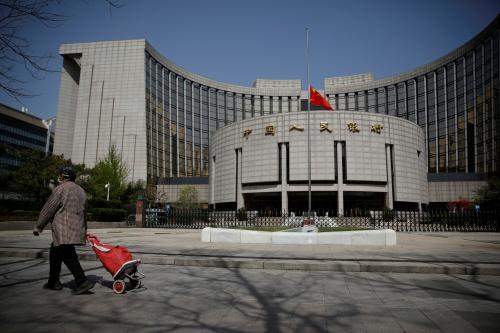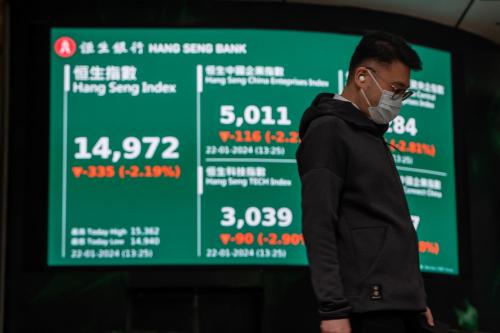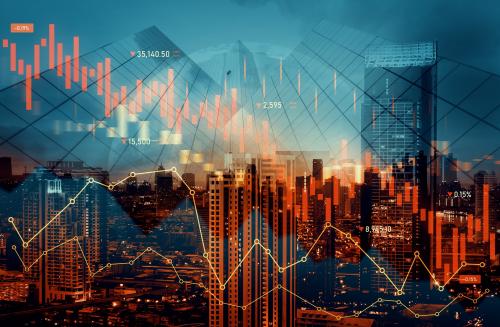China’s buildup of debt to fuel economic growth has raised fears of an eventual collapse. So, what factors would precipitate such a collapse? And if one were to occur, how would it affect the rest of the world? How can Chinese policymakers guard against financial crisis? These are questions that Bloomberg Economics Chief Economist Tom Orlik takes up in his new book, China: The Bubble That Never Pops. Orlik joins David Dollar in this episode to discuss China’s economic growth model, the potential for reforms, and how the economy has responded to the trade war and COVID-19.
Related content
China: The Bubble that Never Pops
The COVID-19 recession is a good time to accelerate Chinese reform
This transcript has been lightly edited for clarity.
Dollar: Hi, I’m David Dollar, host of the Brookings trade podcast “Dollars and Sense.” Today, my guest is Tom Orlik, chief economist of Bloomberg Economics and the author of the new book, “China: The Bubble that Never Pops.” So welcome to the show, Tom.
Orlik: Great to be here, David. Thanks for having me on.
Dollar: So, you lived in Beijing for a long time. I think 10 years, if I remember correctly. And you’ve seen both the best and the worst of China. Let’s start with the positive. What are some of the things you saw that help us understand how China has been successful and dynamic?
Orlik: So, I think one of the prevailing narratives about China that we hear in the West is that because of the single–party state and because of the large presence of the state in the economy, the policy space and the market space is both kind of sclerotic. Right? There’s just been a kind of nationwide suppression of incentives to perform – something like we saw in the Soviet Union in the 1970s and 1980s. And I think that’s sort of an important underpinning of the China collapse pessimism or China collapse theories that implicitly inform U.S. views on China.
It’s certainly true that the political system and the state ownership in the economy have a depressing impact, but my overwhelming impression from meeting with Chinese policymakers, Chinese workers, and Chinese entrepreneurs was a sense of dynamism, forward-looking optimism, and ingenuity. So, if we just think about the central bank, the People’s Bank of China, I think one of the things which strikes me about the People’s Bank of China over the last fifteen years is just how much policy innovation there has been there. From the reform of the interest rate system, to the reform of the exchange rate system, to the steps which they’ve taken to begin de-risking the financial system. It just strikes me as a kind of very energetic and ingenious institution.
Clearly there’s a huge number of problems in China. Clearly there are a huge number of problems with the social system. But if we focus narrowly on the economics, the impression I came away with from discussions with policymakers, discussions on the ground, was that sense that people were motivated and did have an incentive to think outside the box.
Dollar: That’s a really nice point, Tom, about policy space. My experience in China as well was that there really was a lot of room for debate on certain topics. A lot of the issues you take up about the financial sector and debt and the growth model, you know, these things are actively debated. Other topics are completely taboo and I’m certainly not defending Chinese authoritarianism, but nice point about a lot of freedom – freedom may be too generous a word – but a lot of space for policy debate.
So let’s turn to your book. A key point of it is that China has relied a lot on the build-up of debt, that is rapid growth of credit in order to fuel growth. So, how would you summarize the basic story of your book? Why do they need this rapid credit growth? Who’s doing the borrowing? Who’s doing the lending?
Orlik: So the original sin of China’s economy and China’s unbalanced growth model is an extremely high savings rate. China saves a very, very high proportion of its national income. And to turn that saving into demand, there’s two possibilities. They can lend it overseas and then it comes back to the Chinese economy in the form of export demand. And that’s what they did very successfully in the 1990s and even more after they entered the World Trade Organization in 2001. Or, they can lend it to themselves, and then it comes back in the form of investment. After the great financial crisis, exporting wasn’t really working anymore, so the model switched from turning saving into exports to turning saving into investment. And so from 2008 on, we had just an astonishingly rapid buildup of debt in the financial system.
In 2008 extending borrowing was up by 140% of GDP. By the time you get to 2015, it’s gone all the way up to 250% of GDP. And when we look around the world, we can’t actually find any other economies which have taken on so much debt in such a short period of time. But we do find a bunch of economies like Korea in 1997, the U.S. ahead of the Lehman shock in 2008, Greece and other countries ahead of the European sovereign debt crisis, which took on a lot of debt – not as much debt as China, but a lot of debt – and they had a financial crisis. So the concern people have looking into China is: you’ve borrowed so much, you borrowed so much in such a short period of time, surely you’re going to have a bunch of bad loans. Surely your banks are going to fall over.
Dollar: So given that buildup in debt, obviously there’s a risk of a financial crisis. That‘s a key point of your book. You don’t see that as the most likely scenario – we can come back to that – but it’s certainly a possibility. What might be some of the precipitating events? There’s the coronavirus, the trade war with the U.S., or something that I haven’t thought of yet – are these possible precipitating events for a financial crisis?
Orlik: That’s a great question. When we think about a financial crisis, you need two conditions to be met to have a financial crisis. You need a bunch of bad loans and you need the funding for the banks to dry up. So if you think about the Lehman shock, for example, both of these things happened. Right? Lehman had a bunch of investments in mortgage-backed securities which turned out to be much riskier than Lehman had realized. Then when the investors which were funding Lehman’s operations realized that Lehman had these very risky positions, they pulled away their funding and Lehman collapsed. So you need both of these things to be in place. You need the bad loans, but you also need the funding for the banks to disappear.
So this is kind of a useful framework for thinking about what could trigger a crisis in China. And you already have one of the conditions. Right? There’s already a lot of bad loans in China. If we look at the balance sheets of the city banks then we see a very large buildup of sort of shadowy investments; probably money which has already been lent to borrowers that can’t service their loans. So there’s a lot of bad loans there, and problems like the COVID shock, problems like a renewed trade war with the U.S. if that’s what we get, would make that worse. Right? Because problems like that, they hammer incomes for borrowers. They make it harder for them to service their debt, and so they mean we’re more likely to have bad loans.
The other condition for a financial crisis, the disappearance of funding, or the drying up of funding for the banks, that’s the condition which is not met in China. And one of the big arguments in my book is that because the savings rate is very high, and because it’s still difficult to take money out of the country, banks have a very solid funding base. And that’s why, even as we see hidden bad loans increase, we don’t see China’s banks falling over.
Dollar: Right. So I basically agree with you there, Tom. One thing I worry about – a key part of all this is that China has pretty effective capital controls. So there’s real limitations on how much people can take out of the country and they seemed to work pretty well. But I assume whether capital controls work or not depends a lot on the state of the world. And if Chinese people really lose confidence in their system then there are probably a lot of ways around the capital controls that haven’t been discovered yet. And I don’t see that happening at the moment, but to me that’s a fundamental issue. You know, are people losing faith in the Chinese system.
Orlik: Yeah, I think you’re completely right. I was in Beijing in 2015–2016 at that moment where we had a collapse in the Chinese equity market and that botched devaluation of the yuan by the People’s Bank of China which triggered that sort of panicked moment when hundreds of billions of dollars left China very quickly. And that was a moment where, I think, there was a genuine sense of panic and a genuine fear that perhaps the risks could crystallize because, of course, if you have enormous capital outflows, then you do have the funding for the banks disappearing, and that is a moment when a financial crisis could happen. But what Beijing did in that moment was quietly tighten the screws.
I remember going to the bank at that period to try and transfer some of my earnings into dollars and move them out of the country. And the paper trail…no one said no, but the paper trail that was required was kind of a mile long. At one point my bank said your employment contract is not long enough. So, yes, ultimately if Chinese people lose faith in the Chinese economy and we see mass capital flight, that is not something the Chinese government is going to be able to easily control, especially because the trade account is so big and there’s so many ways of hiding capital flows in the trade account. But what we saw in 2015–2016 was that they are actually quite good at tightening the screws when they want to.
Dollar: So if the bubble in China does pop and there’s a financial crisis, can you sketch out what it might look like? How it affects China and how it would affect the U.S. and the rest of the world?
Orlik: So you have a shock to China and that shock ripples out and hits the rest of the world. So what happens in China? Well, it starts with a default for a single borrower. Banks recalculate the risks associated with lending to similar borrowers. They start pulling back lending. They start refusing to roll over loans. Defaults spread, and what starts as a kind of a single default spreads out to be a systemic crisis. Businesses which rely on credit – which of course is all businesses – and don’t have enough cash flow to keep themselves solvent start going bankrupt. They start letting go of workers, demand disappears, and you have a kind of a self-feeding shock similar to what we saw in the United States after the Lehman shock in 2008. So China’s growth, which let’s say after the COVID shock goes back to 4-5 percent a year, craters, and you have a period of contraction in China’s economy.
Now, when the U.S. financial system blew up in 2008–2009, it was the financial linkages which spilled around the world and caused problems for European banks and Japanese banks and Latin American banks. And then, of course, the collapse in U.S. demand had a second round effect. So all of these countries had a financial shock and then they had a real economy shock because demand for imports from the U.S. disappeared.
In China, as you know, David, financial linkages with the rest of the world are just not that well developed. There aren’t a lot of businesses around the world, or a lot of banks around the world, that have very close or very important connections with the Chinese banks. So if China’s financial system implodes, then we don’t actually see that immediate financial ripple effect. What we would see is a kind of a risk–off mood, a risk–off moment for global financial markets. So you’d expect to see equity markets in the U.S. and Europe and Japan collapse; potentially with significant negative confidence effects which would hit those economies immediately. And then – this is the bigger one – you see a real economy impact.
China’s a very significant driver of demand for exports, especially for commodity producers like Australia or Brazil or Chile. So they suffer substantially. China is also now a very substantial driver of demand for other countries in the Asia region. So Chinese tourists disappear, Chinese consumer demand falls, and countries in the region, like Thailand, for example, see their grade fall very sharply. Asian countries are also extremely integrated into the Chinese electronics supply chain. So if we see a financial crisis which hits the Chinese manufacturing sector, and we see the big electronics producers on the East Coast go bankrupt, then that also has a negative impact on Japan and Korea and the Philippines and other countries that feed into that electronics supply chain.
What does it do to Europe and the U.S.? Well, actually, the impact there is a bit less, and there are some countervailing positives. So the impact is a bit less because those countries are much further away. And, yes, they export to China, but not as much as a commodity producer or an Asian neighbor. And most of these countries are commodity importers. So, if China collapses, and the price of oil, for example, collapses, that’s actually good news for some European countries because it means their import bill falls.
Dollar: Let’s talk a little bit about the response to the coronavirus. The natural response we’re seeing all around the world is big Keynesian stimulus through fiscal policy, monetary. The numbers in Japan and the United States are overwhelming; as much as 20 percent of GDP in the case of Japan.
I find it interesting that China actually seems rather modest in terms of the stimulus it’s rolling out. China lacks transparency on some of this, but to the best we can estimate, it is providing fiscal and monetary stimulus but far less than the United States or Japan. So does this mean the technocrats, or the top leaders behind them, are they getting serious about controlling leverage? Is this a response to the kind of worries that are raised in your book?
Orlik: I think that’s a really interesting question, David. I think there’s a few things going on. The first thing is that they really overdid it in 2008. That famous four–trillion yuan stimulus, which Premier Wen launched, was very effective at offsetting the impact of the great financial crisis, but the stimulus went on for too long and it’s left China with this legacy of a huge amount of debt. So they just don’t have space to run another very big stimulus.
I think the second thing is that China has some instruments which other countries do not have. So the state sector in China is very big and very inefficient and a big source of corruption. And that’s probably a net negative for China, but it’s also an instrument which the government can use to act as a kind of countercyclical buffer. So the private sector isn’t hiring, the private sector isn’t investing, but the government can instruct the state sector to keep hold of their employees and to accelerate investment projects. I think maybe this is what you were hinting at with your point about transparency. It’s not fiscal stimulus; it’s kind of a quasi-fiscal stimulus so it doesn’t show up on the Ministry of Finance’s books, but it has a similar type of impact on the economy.
Dollar: So ultimately you’re cautiously optimistic, I would say, in that you don’t see the financial crisis as the most likely scenario. But you highlight some serious risks. What are the most important things for China to do to continue healthy growth without a financial crisis? You’ve touched on some of them, but what would you add in terms of the policy agenda for China?
Orlik: So to continue growing China needs to engineer a set of mutually reinforcing reforms. They need to restore the link between credit growth and growth in the real economy so that they can grow without massively adding to the existing levels of debt and leverage. They need to continue a transition from manufacturing to services. They need a smaller and more efficient state sector, leaving more room for a dynamic private sector. That’s one area where they’re certainly not making progress and indeed going in the wrong direction in the last few years. And they need a larger role for consumption, a smaller role for investment. And they need to have a more environmentally sustainable growth model.
So that sounds like a lot – it is a lot. But in fact, all of these transitions are mutually reinforcing. Right? So the service sector is more capital-light than the industrial sector. The service sector is more carbon-light than the industrial sector. And the service sector is more labor intensive than the industrial sector. So, as you transition from industry to services, you don’t need so much credit, so the relationship between credit growth and the rate economy gets better. You don’t burn so much carbon, so your economy becomes more environmentally sustainable. And you employ more people, so labor demand goes up, wages rise more quickly, and hopefully you get stronger consumption.
There’s a huge amount to do. In some respects, China’s moving in the wrong direction, especially on the relationship between the state and the private sector, but many of these transitions are interlinked and mutually reinforcing, so I think that’s a sort of a basis for cautious optimism.
Dollar: I see a common thread running through a lot of those recommendations is the need to open up and create more competitive markets in different areas. And the natural response to the coronavirus might be to close things off. We’re seeing that around the world, which I think is quite unfortunate. So it takes a quite a bit of leadership and even courage to go in the other direction. I mean, on a positive note, you probably noticed that China reached an agreement with ASEAN and Japan and South Korea on the RCEP trade agreement, which is modest, but still it’s a positive step in the right direction that will force China to open up its markets a little bit more.
Orlik: Years ago I decided to myself that I could only absorb a certain number of acronyms, and the RCEP trade agreement didn’t make the cut. So, I didn’t track developments there, but it certainly sounds like it sounds like a positive one.
Dollar: Right, it’s the Regional Comprehensive Economic Program, and for a long time we economists kind of pooh-poohed that it’s not nearly as deep integration as in the Trans-Pacific Partnership, but it’s pretty serious trade liberalization. Curiously enough, its positive effects in some sense are quantitatively about the same as the negative effects of the U.S. trade war. So you could say that China is undoing the trade war by participating in this Asia Pacific-wide trade liberalization.
In fact, that brings me nicely to the last topic I want to take up, Tom. Not so directly relevant to your book, but obviously in everyone’s mind: U.S.-China relations. It’s related in the sense that hostility or the trade war from the U.S. has to make China’s growth a little bit more difficult and raise the risks of some kind of financial crisis. You’ve been covering U.S.-China relations for a long time. Do you see much prospect for an improvement? Do you think things are going to get worse? How do you read U.S.-China economic relations?
Orlik: I think the question is, is Donald Trump going to turn out to be an aberration in terms of his approach to U.S.-China relations, or is he going to turn out to be a kind of turning point? Of course, that question might not be important. We’ve got an election in November. It’s possible that President Trump will win, and so if that happens I would anticipate we’d have something that looks like continuity in U.S.-China relations. If Biden wins, then we’ll find out. Has Trump identified the new trajectory for U.S.-China relations and is that going to be the trajectory going forwards, or was he a moment and actually we’re going to go back to more constructive engagement? I suspect that actually it’s the former.
I think that fear of China’s rise is not something which is unique to President Trump. I think it is fairly widespread among U.S. voters. And indeed, I think it’s sort of a growing feeling in Europe, Australia, and elsewhere as well. I think we’re at the beginning of a global shift where businesses and governments view China less through the lens of an opportunity to be tapped and more through the lens of a risk, or even a threat, that has to be managed.
That’s going to be a problem for China. It’s going to be a problem because it’s going to restrict global export markets for Chinese goods and Chinese services. A bigger problem for China, I think, is that China is still playing catch-up on technology, and the quickest way to catch up is to learn from overseas – or if we’re being less charitable, to steal from overseas. And that was a process which worked very nicely for China up until quite recently. There were basically no constraints on multinationals setting up shop. There were limited constraints global research partnerships. There was limited pushback even on intellectual property theft. And now that door to technology transfer is creaking closed, and I think that’s going to be a long–term and potentially rather serious drag on China’s capacity to develop and to drive productivity growth.
Dollar: I’m David Dollar, and I’ve been talking to Tom Orlik about his new book “China: The Bubble That Never Pops.” It’s a really enjoyable read that you can buy from all the usual places. It gets into some really complicated issues about China’s growth model, financial sector, risk of financial crisis, but explains it in a very non-technical and enjoyable fashion. So, thank you very much for joining us, Tom.
Orlik: Thanks very much, David. I felt when I was writing the book that I was very much indebted to the powerful analysis and insights of a whole group of China analysts. Over the years, I learned a huge amount from reading your work and occasional opportunities to speak with you. So, thank you very much.
Dollar: Thank you.
And thank you all for listening. We’ll be releasing new episodes of Dollar & Sense every other week, so if you haven’t already, make sure to subscribe on Apple Podcasts or wherever else you get your podcasts and stay tuned.
Dollar & Sense is a part of the Brookings Podcast Network. It wouldn’t be possible without the support of Shawn Dhar, Anna Newby, Fred Dews, Chris McKenna, Gaston Reboredo, Camilo Ramirez, Emily Horne, and many more. If you like the show, please make sure to rate it and leave us a review. Send any questions or episode suggestions to [email protected]. And, until next time, I’m David Dollar and this has been Dollar & Sense.






Commentary
PodcastWill China’s debt bubble ever pop?
July 13, 2020